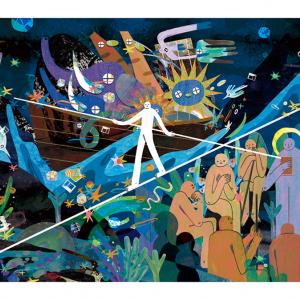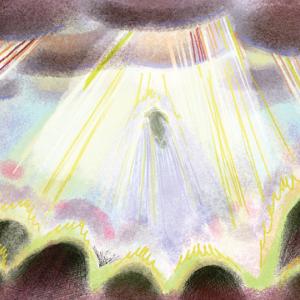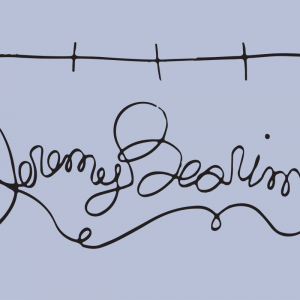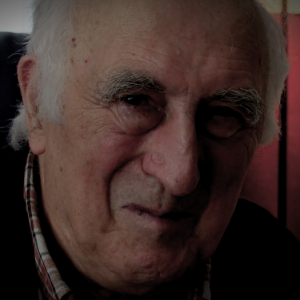
Natalie Wigg-Stevenson, curator of the online resource “Transgressive Devotional” and author of Transgressive Devotion: Theology as Performance Art, teaches at Emmanuel College in Toronto.
Posts By This Author
How Queer Theology Can Invigorate Advent's Anticipation
“THE CONTEMPLATIVE ON her knees well knows the messy entanglement of sexual desire and desire for God,” writes theologian Sarah Coakley. If she’s right, then attending to what arouses us sensually can teach us something about how God lures us through our longing and, even, how we can attract God’s intimacy. This month, we’re exploring how queer theology can invigorate (dare I say, stimulate?) the anticipation we build throughout Advent. This approach may seem blasphemous to some who aren’t familiar with a queer-affirming lens ... and perhaps uncomfortable to some who are. Many of us are steeped in Christian body-denying theologies and moralities. We are uncomfortable meeting God in ways that are playful, erotic, unnerving, and always cognizant of power dynamics (though scripture is steeped with such sexual innuendo). Queer theology starts from (rather than argues for) not just queer affirmation, but queer celebration. It can expose the erotic dimensions of our sacred stories to reveal God’s wild and promiscuous desire for all creation.
December is a season for sending Christmas cards depicting the Holy Family — perhaps the most heteronormative image in the church year: A mom and dad stare lovingly at their beautiful baby. This static image can obscure the mess of desire, power, submission, and surprising gender fluidity required to incarnate this Holy Child. What moves in us as we ponder the design of different Christmas images that don’t shy away from this beautiful mess? What images help us face the wonder and terror of what it feels like to be undone and remade by God’s overcoming?
‘Everybody Knows It's Coming Apart’
ACROSS THE UNITED STATES, people will soon be preparing for Thanksgiving. We’ll name what we’re grateful for and then, in an ironic turn, let “Black Friday” convince us we need more. “Cyber Monday” will catch all the credit cards that made it, un-maxed, through the weekend. “Giving Tuesday” lets us pay the virtue toll to keep spending guilt-free on the yet-to-be-named following Wednesday. Whew! The consumerist drive in November and December makes the temporality of liturgical living difficult. But let’s try. November marks the end of both Ordinary Time and the church year. Ordinary Time is the day-in, day-out rhythm of everyday life as we await Christ’s second coming. In these final weeks, we’re not quite waiting on Christ, then — as we do during Advent — so much as we’re preparing ourselves to wait.
Come Advent, the scripture readings will be filled with anticipatory hope. But, as the old church year ends, the passages are full of anxiety and dread. The Hebrew Bible selections spotlight the escalating threat of the coming judgment. Paul’s letters pour out end times panic. Or, as songster Leonard Cohen put it, “Everybody knows it’s coming apart.” In Matthew’s gospel, Jesus forces us to ponder which side we are on. It’s not easy to sit with all this. I want to skip over to Advent hope (or even Christmas joy). But I invite us to hospice the old year’s death throes before welcoming new life at the stable door.
When We Feel ‘Angry Enough to Die’
SEVERAL OF THIS month’s lectionary readings deal with the tensions of navigating wrongdoing, judgment, vengeance, and forgiveness. They call readers to forgive — and forgive again: not just once, twice, or seven times, but at least 77 times and counting (see Matthew 18:22).
These texts have been used throughout history to trap people in positions of disempowerment, abuse, and enslavement. Consider, for example, how victims of intimate partner violence have been pressured to forgive and return to their abusers, who then proceed to hurt them again. Or how entire marginalized communities are expected to “get over it,” whether that is the colonization of Turtle Island, enslavement, or generations of misogynist, queer- and transphobic policies, laws, and violence. In light of the rampant misuse of these texts, we’re right to be wary of biblical interpretations for how to handle conflict that reinforce domination. The texts tend not to deal directly with inherent interpersonal and structural power dynamics. We must do that work ourselves. Any of us preaching the lectionary this month must also be careful.
Attending to the power dynamics of these passages doesn’t mean we dismiss them as useless. Rather, such attention helps us discern how these texts invite and bear witness to God’s presence in processes of interpersonal, intergenerational, and even international healing. They call us to attend to what our own pain has to teach us and to seek hope through community life. And they promise that throughout our attending, God will abide — waiting patiently to see us through.
Aligning With Our Ancestry
IN 2012, a group of scientists from the University of Washington discovered Y chromosomes in the autopsied brains of female cadavers. Finding so-called male DNA in cis women’s bodies certainly complicates our notions of gender! But the focus then was on introducing the sci-fi-sounding concept of fetal microchimerism. Fetal cells, we learned, can remain integrated at the genetic level in someone’s body long after the fetus or baby is not. These cells can be passed on to future siblings, thus embedding visceral relations within our bodies that even the most adept family-systems theorist would struggle to disentangle.
The scientific community labeled this a discovery. But for anyone already skeptical of the mind-body dualisms in Western culture, this was simply science catching up with how we already experience our ancestral relations. Intergenerational wisdom and trauma aren’t simply intellectual concepts. Rather, our ancestors’ presence in our lives connects at sites where body, spirit, mind, and soul inextricably intertwine. And these sites are in desperate need of some decolonizing attention if we’re to reclaim our ancestral relations in our practices of Christian faith. Of course, that might not be something we all want to do. But this month, I’ll engage the lectionary readings through this lens to see what questions and insights might arise. And I’ll do so with the hope that our wide, wondrous communion of saints will read along with us.
Attempting the Impossible
JEWISH NEW TESTAMENT scholar Amy-Jill Levine claims that all religions are a little bit supersessionist. Christian supersessionism — which understands God’s covenant with Christians to nullify God’s covenant with the people of Israel — has been so mainstream throughout most of Christian history that it has hardly required articulating. It was just the anti-Jewish water in which we swam. Following the Holocaust, however, Christians recognized how much we’d weaponized supersessionism into antisemitism, which provided support for Nazi and white supremacist ideologies and perpetuated anti-Jewish violence. Unfortunately, Levine argues, no exegetical maneuver can fully expunge supersessionism from the New Testament — though many have tried. It’s there. And the authority of God’s word in Christian lives keeps its dangerous power ever-present.
Still, Paul’s letter to the church in Rome (which we read this month) contains Paul’s own grappling with these questions. Chapters 9 to 11 — wherein Paul corrects some of the Gentile converts who think God has now rejected the covenant with Israel — comprise the hook on which most contemporary attempts to dismantle supersessionism hang their hat. So, we’ll pay special attention to these.
This isn’t going to be an easy fix — particularly for Christians (like me!) who want to hold fast to the gospel, atone for complicity with antisemitism, and stand in solidarity with Palestinians under occupation. Still, I trust God’s promises: I believe both that God’s covenant with Israel endures and that Jesus is the Messiah. So, this month, we are going to sit with the discomfort of failing while attempting the impossible. Because, in trying, we might find a new way through.
Tending the Shoots of Redemption
BEFORE THE PANDEMIC hit, I could have told you the precise number of my indoor plants: zero. But then lockdown started and, like countless people around the world, I became obsessed with all things leafy and green. Once I learned how to keep a plant alive, I began to nurture cuttings. To see that first fresh leaf grow — an assurance that new roots had taken hold — filled me with a kind of joy heretofore unknown.
I needed to feel like life could not just survive, but flourish and thrive. “Give this at least six weeks before repotting,” I would text a friend from her porch as I dropped off the gift of a budding leafy monstera, “just to let the roots settle.” Then I’d trudge back to the sidewalk to watch my friend open her door, wave to me, and take this small extension of myself into her home. Months later, when we could visit in person, I’d get to see how much these little ones had grown. Great leafy extensions of love.
Most of the gospel readings this month contain horticultural parables — seeds and soil, wheat and weeds, sowers and reapers. Before the COVID-19 years, I had never read these parables through the eyes of someone who had nurtured plants to life. Their images had been abstractions, ideas, metaphors with no roots. But now that those seeds have grown, I see each one anew. Perhaps you do too?
God Births Creation
WE HAVE SEVERAL readings this month where God creates something out of nothing — or at least out of pretty limited materials. In the opening chapters of Genesis, we see creation birthed from God’s imagination and curiosity. In the story of Sarah and Abraham, a child is conceived in a womb so postmenopausal that the now-pregnant woman can’t help but laugh (Genesis 18). A well appears from nowhere to quench the thirst of a dying woman and her child (Genesis 21:19). God “calls into existence the things that do not exist” (Romans 4:17). And God turns death to life through the mysteries of resurrection (Romans 6:1-11).
This month’s lectionary readings make God’s continuous creation — as well as God’s continual renewal of creation — explicit. But the fact is, once we’re looking for it, all of scripture tells these stories of renewal. God is always creating, re-creating, and reimagining our world. God is always making a way where there was no way before. God continually turns death to life. And, just as importantly, we are called to participate in God’s divine practices of continuous creation, in God’s own divine practice of everyday resurrection.
As we exit a series of some of the higher holy seasons in the liturgical year — Epiphany, Lent, Easter, and Pentecost — June quiets down from such intensity. The slower pace to which (in some places) the warm summer sun calls us can inspire us to seek out everyday resurrection wherever God hides it. How is the Spirit calling you to partner with divine practices of renewal, with everyday resurrections?
‘Goin’ Up to the Spirit in the Sky’
MOST OF OUR gospel readings in May move through sections in John’s gospel commonly referred to as the “farewell discourse.” In this long goodbye, Jesus and his disciples have finished eating their last supper together. Judas has departed to betray his friend. Now it’s time for Jesus’ final words to the remaining 11. Or, at least, it’s time for him to say goodbye from the perspective of who they’ve known him to be thus far. He’s preparing them for who he is becoming, as well as how he’ll continue to be among them — and, by extension, among us. There’s a lot that Jesus wants to accomplish without fully tipping his hand. So, his speech is at times confusing!
Unsurprisingly, a sense of longing permeates the whole address. These friends are saying goodbye to each other while also scrambling for ways to stay together. Jesus is grieving that goodbye, while also anticipating a joyful return to his Abba in heaven. As he speaks, then, Jesus tells of a fluid, swirling kind of love that permeates and connects God, himself, and his followers all to each other. This fluid love is the Holy Spirit that Jesus will “breathe” upon his followers (John 20:22) — the Holy Spirit who lingers among us still.
Our celebrations at Pentecost tend to focus on the wild descent of fiery tongues upon the early Jesus community — as they should. But in this lectionary cycle, the New Testament readings don’t focus on wind, fire, or tongues. Instead, they have us abide in these less dramatic, more subtle, ambiguous, and mysterious moments. This year, Pentecost calls us to abide in and with a love that often doesn’t make sense, but that always must be shared.
‘I Want to Believe’
IN 1633, THE Bavarian village of Oberammergau experienced a miracle. The villagers had promised God they would stage a reenactment of the passion of Christ if they were spared from the plague. They were spared. Nearly 400 years later, people continue to come from around the world to see these performances. But there’s a problem. Oberammergau’s passion play is one of the most antisemitic artworks in European history. Adolph Hitler viewed the play in 1930 and 1934 and recognized its propaganda value for his own plan of Jewish genocide.
Christians today may still perpetuate anti-Jewish racism throughout our passion narratives — particularly when the gospel of John forms the core of the lectionary. Unlike the others, John’s gospel frequently labels anyone opposing Christ as “the Jews.” Most of us realize that the writer is naming a subset of religious leaders. But when we repeat the phrase throughout Easter, we can subconsciously reproduce and amplify antisemitism found in the Christian theological imagination.
Recently, rather than ignoring the passion play’s antisemitism, the director worked with the American Jewish Committee to rid the play of anti-Jewish tropes. The 2022 Oberammergau passion play told a more complete Easter story. “The Jews” now include Jesus and his followers too. Jesus lifts a copy of the Torah to pray the Sh’ma Yisrael. Hebrew prayers were recited over the Last Supper. Mary is greeted as the “rabbi’s mother.” Significantly, the updated version calls Christians to repent for how we’ve failed our foundational sibling relationship.
The Light of Our Flesh and Souls
WITH THIS MONTH'S liturgical arc, we move from Epiphany to Lent: from a season of illumination to one of penitence. You’d think they would be reversed, though. You’d think it would be necessary to do the soul-searching first, to clean house before we get to invite God over for tea.
But the natural order of things always becomes topsy-turvy when God gets involved. God’s time “doubles back and loops around and ends up looking something like ... the name ‘Jeremy Bearimy’ in cursive English,” as Michael (Ted Danson) explains to Eleanor (Kristen Bell) in television’s The Good Place. The dot over Bearimy’s “i” represents Tuesdays, July, and “when nothing never occurs.”
Joking aside, this is the gift of the liturgical calendar: It lets us glimpse what it’s like to live in God’s time rather than our own. We don’t need to be worthy of an encounter with God before that encounter can happen because we constantly live in the kingdom space of already-not-yet. Revelation and repentance are like the proverbial chicken and egg: No one really knows which comes first, and it probably doesn’t matter in the end.
Divine time’s topsy-turvy nature is also why Christians are called to discern the difference between the “wisdom of this age” and God’s wisdom (1 Corinthians 2:6-7). What this month’s readings might call us to ponder, then, is not where human and Divine wisdoms diverge but, rather, where on Jeremy Bearimy’s curves they converge. Perhaps even on the dot of the “i.”
The Risky Business of Incarnation
MY SEMINARY PREACHING professor used to say that we should only tackle one of each week’s lectionary texts in our sermons, maybe — just maybe — tying in a second. Over the course of a career, a great preacher might have a couple of three-text sermons in her. But only a foolish preacher tries to preach all four. The problem with this month’s readings is that they contain a lot of four-text temptations. Their cumulative effect, though, tends toward incarnation: not just God enfleshed in Jesus, but God enfleshed in us all and, even, in all creation.
By the end of the month, Lazarus will be raised from the dead (John 11:1-45). He and his sisters, Mary and Martha, were among Jesus’ closest friends. So, it seems odd to me that when Jesus first hears the message that Lazarus is ill, he seems to shake it off (verses 3-4). I wonder if Jesus was surprised, then, when he learned that Lazarus had died (verse 32). I wonder if he was shaken, suddenly uncertain about his certainty. Later, Lazarus’ resurrection prefigures Christ’s own rising again in glory. But at this point in the story, we don’t yet know that life is coming. All we can see is death.
That’s the risk of incarnation; it’s the risk of not knowing. And that risk is why I find this story (and the arc that leads to it) so comforting. My comfort comes not just in knowing that Lazarus came back to life. More so, my comfort comes in knowing that, like us, Jesus — God in flesh — risks not quite knowing the way to and through the ending.
Blessing Our Comings and Goings
JANUARY OPENS THE season of Epiphany: In the North, the light begins to last longer, and we reawaken to the world outside our doors. Each Jan. 6, my family performs the old European Epiphany ritual of “chalking the door” to our home. While I pray, my spouse hoists our kids up to write the blessing on our front lintel. This year the markings will look like this: 20+C+M+B+23. Twenty marks the beginning of the year. The letters recall the Magi (Caspar, Melchior, and Balthazar) whose visit we celebrate and also the Latin prayer: Christus mansionem benedicat (“May Christ bless the house”). The final number closes out the year. The markings are strange. We’re asked about them often. We recall the great light that led the people out of Egypt, the great star that guided the Magi, and the Holy Family’s hospitality. These signs keep evil spirits out and invite God’s Spirit in. And that’s a lot to explain to the FedEx guy.
But Epiphany is a lot! It invites us to explore the complex roles we play in God’s redemption: our complicity in evil as we reach for the good, our relationship to violence, and how we’ll practice hospitality post-COVID.
In this season we also travel with the community of Jesus-followers at Corinth. Much like them, Christians today have become increasingly divided — even among those who agree on the values of compassion, community, and caring for those most vulnerable. The pandemic has made it difficult to find a vision for how to live out our shared values. What striking illumination will this season bring?
When a Trusted Spiritual Leader Turns out to Be a Sexual Predator
MEN OF POWER have always abused that power. Every woman knows it, which is why none of us were surprised when #MeToo came for the church. But we weren’t prepared for Jean Vanier.
The details of Vanier’s story are well known by now, but they bear repeating. Vanier, who died in May 2019 at the age of 90, was the internationally celebrated co-founder of L’Arche, a global network of homes where people with and without intellectual disabilities live together in community. A Roman Catholic layperson who never married, Vanier was regarded by many as a living saint; his New York Times obituary hailed him as “Savior of People on the Margins.” His writings on spirituality and community were best sellers and universally revered as modern classics.
Vanier was also a sexual predator. A report following a posthumous investigation by L’Arche International, the organization that Vanier founded, revealed that he sexually abused at least six women in his spiritual care between 1970 and 2005. These six cases are the ones we know about. The women, none of whom knew each other, offered remarkably similar accounts of Vanier’s strategy of sexual predation within the context of spiritual direction.
L’Arche’s summary report is excruciating to read, because it reveals a pattern of manipulation and exploitation shot through Vanier’s role as a spiritual director. “He told me that this was part of the [spiritual] accompaniment,” one survivor reported. Even as she told him she was struggling to “distinguish what was right and what was wrong,” he pushed on, offering bizarre scriptural warrant from the Song of Solomon and—perhaps most chillingly—his contention that in their sexual interaction, “This is not us, this is Mary and Jesus.”
White, Privileged, Fragile

lastbackup / Shutterstock
A COUPLE OF YEARS AGO, while doing research on social privilege for an introductory ministry course, I came across an article titled “White Fragility.” Even a skim of the first few pages was enough to pique my excitement. In it, author Robin DiAngelo—an expert in multicultural education—describes in sociological detail a common set of defensive and destructive responses that people have when facing the reality of their own privilege.
I recognized each response she described from those my students had whenever I asked them simply to face—let alone begin to dismantle—the various forms of social privilege they each embody. Where, I began to wonder, could I squeeze this article into an already over-packed course syllabus? How could it best help us navigate the difficult issues we were trying to engage?
Emptying ourselves
Social privilege is a daunting topic to engage. When teaching it, I draw heavily on Peggy McIntosh’s now famous definition of its racial manifestation:
I have come to see white privilege as an invisible package of unearned assets that I can count on cashing in each day, but about which I was ‘meant’ to remain oblivious. White privilege is like an invisible weightless knapsack of special provisions, assurances, tools, maps, guides, codebooks, passports, visas, clothes, compass, emergency gear, and blank checks.
What McIntosh helps us see is that social patterns of privilege are maintained because people carry them about and use them while, at the same time, people are able to carry about and use their privilege because those social patterns are maintained. The effect is cyclical, and it happens without any of us being particularly aware of our own complicity in the system.
Society confers unearned gifts on people who embody particular privileged traits—straight, white, able-bodied, middle-class men, for example—while neglecting to confer them on others. This isn’t to say that people who embody more privilege are explicitly homophobic, racist, ableist, classist, or sexist. It doesn’t mean they don’t work hard for the goods they accumulate in life—of course, many do. It’s just that it feels perfectly natural to walk through an open door without ever noticing how it swings shut in the face of the equally hardworking genderqueer Latinx whose wheelchair wouldn’t even fit.
The Agony and Ecstasy of Baptism

robert_s / Shutterstock
Jesus replied, “Very truly I tell you, no one can see the reign of God unless they are born again.” “How can someone be born when they are old?” Nicodemus asked. “Surely they cannot enter a second time into their mother’s womb to be born!” Jesus answered, “Very truly I tell you, no one can enter the reign of God unless they are born of water and the Spirit. Flesh gives birth to flesh, but the Spirit gives birth to spirit.”
—John 3:3-6
IN THE WEEKS LEADING UP to my child’s baptism, I wrestled with this passage from the gospel of John. While it doesn’t explicitly mention baptism, most of the churches where I had worshipped over my years as a Christian nevertheless drew significantly on it when they articulated their understanding of what it is we’re doing in the waters. And so, experiencing a deeply conflicted desire to raise my child—my daughter—in the church, I prayed for God’s Spirit to release fresh insight from old wisdom. I was yearning to understand what it was we were about to do.
Nicodemus is almost always presented as a fool in this story. What a silly question! What a silly man, thinking that there might be any kind of a special relationship between a person’s first birth and their second! I’ve never heard a sermon or attended a Bible study where we acknowledge that for someone hearing this brand new and seemingly nonsensical concept of being born again, Nicodemus’ question is perhaps the most logical one to pose.
Even more to the point, I’d never noticed before that Jesus’ answer to the question doesn’t dismiss the validity of a mother’s labor as the very context out of which we should understand what it is that happens in baptism.
It’s patriarchal theology that did that.
Now, the phrase “patriarchal theology” might be an offensive one simply to toss around. So let me just tip my hand: I’m a card-carrying feminist theologian, Baptist minister mama. From some angles I look like a jumble of contradictions, contradictions that I try to live with grace and glee.
But it’s not the fact that I’m a Baptist that gave me pause on the decision of baptizing my infant daughter in the Anglican church in Toronto where our ecumenical family happens to worship. Of course, as a Baptist minister I affirm the theology of baptism as an outward expression of an inward conversion, an expression that requires one be of a certain age to be able to proclaim it. But at the same time, my ecumenical sensibilities and general disposition of theological expansiveness mean that I simultaneously affirm a more Anglican theology of baptism—which sees God’s invitation to the community of faith as occurring through a grace that precedes our awareness of it. So, being a Baptist married to an Anglican, I didn’t really struggle with the idea of baptizing our daughter on account of her infancy.












